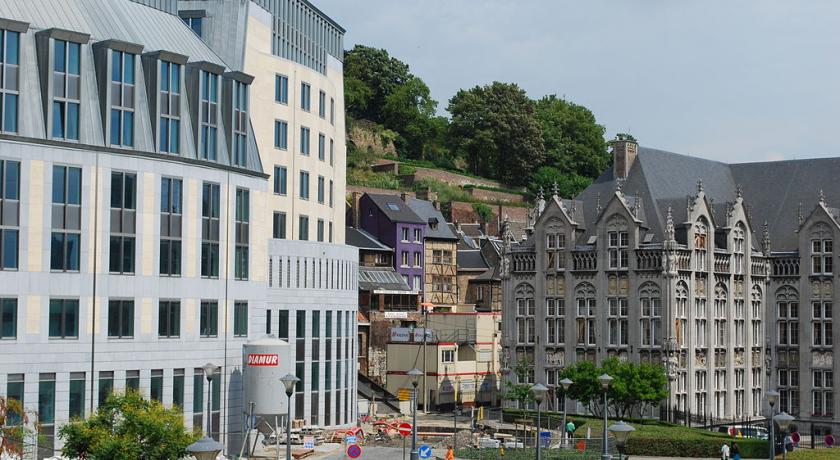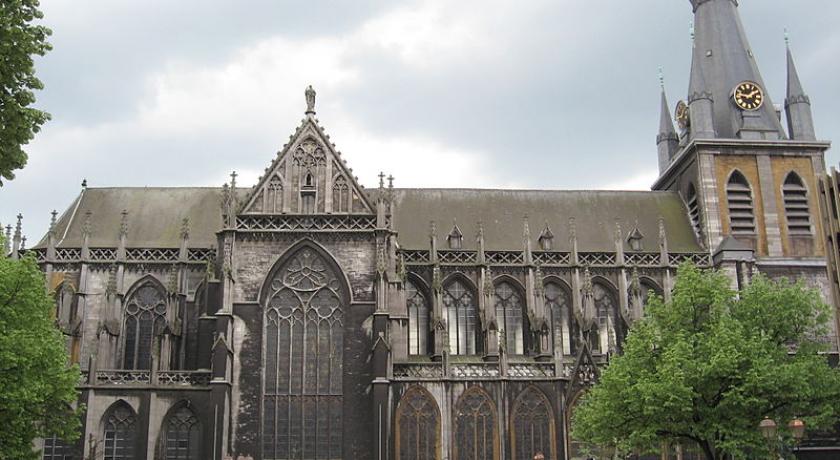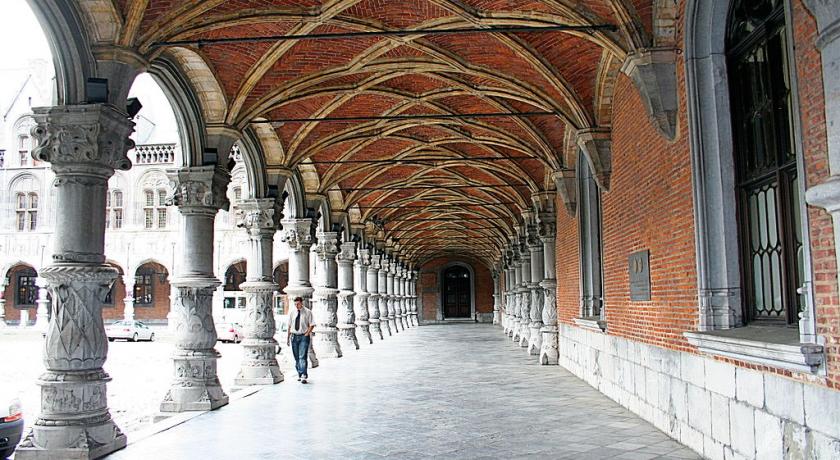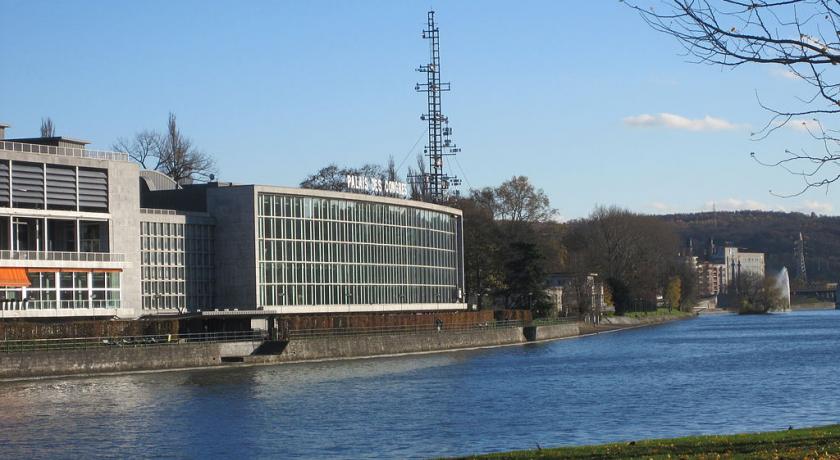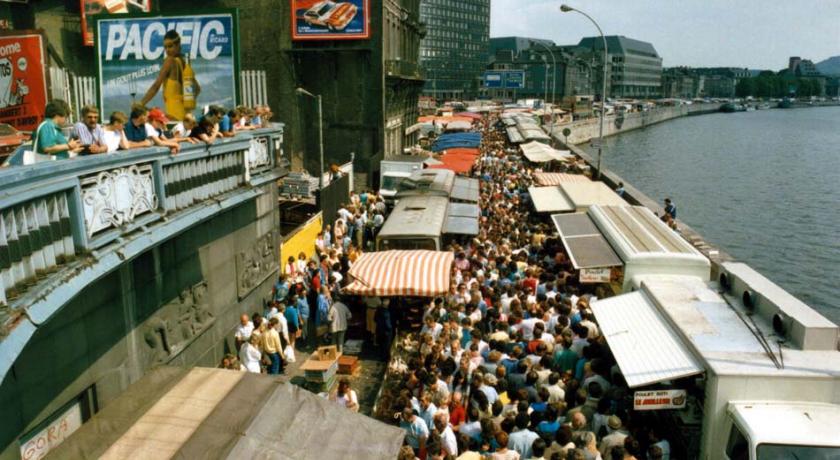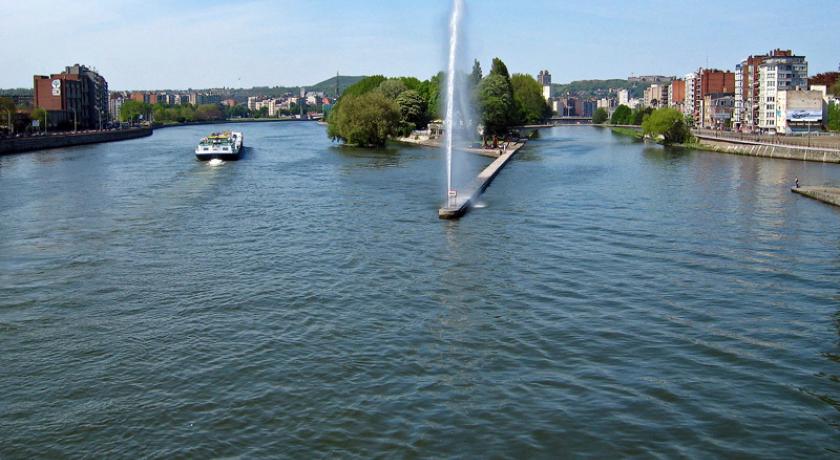Description
Liège in Belgium; Walloon: Lidje; Dutch: Luik; German: Lüttich) is a major city and a municipality in Belgium. It is the main city of the province of the same name, Liège, in Belgium's francophone region of Wallonia.
The city is situated in the valley of the Meuse River, in the east of Belgium, not far from borders with the Netherlands (Maastricht is about 33 km (20.5 mi) to the north) and with Germany (Aachen is about 53 km (32.9 mi) north-east). At Liège the Meuse river meets the river Ourthe. The city is part of the sillon industriel, the former industrial backbone of Wallonia. It still is the principal economic and cultural center of the region.
The Liège municipality (i.e. the city proper) includes the former communes of Angleur, Bressoux, Chênée, Glain, Grivegnée, Jupille-sur-Meuse, Rocourt, and Wandre. In November 2012, Liège had 198,280 inhabitants. The metropolitan area, including the outer commuter zone, covers an area of 1,879 km2 (725 sq mi) and had a total population of 749,110 on 1 January 2008. This includes a total of 52 municipalities, among others, Herstal and Seraing. Liège ranks as the third most populous urban area in Belgium, after Brussels and Antwerp, and the fourth municipality after Antwerp, Ghent and Charleroi.
Etymology / Origin
The name is Germanic in origin and is reconstructible as *liudik-, from the Germanic word *liudiz "people", which is found in for example Dutch lui(den), lieden, German Leute, Old English lēod (English lede) and Icelandic lýður ("people"). It is found in Latin as Leodicum or Leodium, in Middle Dutch as ludic or ludeke.
Until 17 September 1946 the city's name was written Liége, with the acute accent instead of a grave accent.
In French the city has the epithet la cité ardente (the fervent city).
History
Early Middle Ages
Although settlements already existed in Roman times, the first references to Liège are from 558, when it was known as Vicus Leudicus. Around 705, Saint Lambert of Maastricht is credited with completing the Christianisation of the region, indicating that up to the early 8th-century the religious practices of antiquity had survived in some form. Christian conversion may still not have been quite universal, since Lambert was murdered in Liège and thereafter regarded as a martyr for his faith. To enshrine St. Lambert's relics, his successor, Hubertus (later to become St. Hubert), built a basilica near the bishop's residence which became the true nucleus of the city. A few centuries later, the city became the capital of a prince-bishopric, which lasted from 985 till 1794. The first prince-bishop, Notger, transformed the city into a major intellectual and ecclesiastical center, which maintained its cultural importance during the Middle Ages. Pope Clement VI recruited several musicians from Liège to perform in the Papal court at Avignon, thereby sanctioning the practice of polyphony in the religious realm. The city was renowned for its many churches, the oldest of which, St Martin's, dates from 682. Although nominally part of the Holy Roman Empire, in practice it possessed a large degree of independence.
Late Middle Ages and Renaissance
The strategic position of Liège has made it a frequent target of armies and insurgencies over the centuries. It was fortified early on with a castle on the steep hill that overlooks the city's western side. In 1345, the citizens of Liège rebelled against Prince-Bishop Engelbert III de la Marck, their ruler at the time, and defeated him in battle near the city. Shortly after, a unique political system formed in Liège, whereby the city's 32 guilds shared sole political control of the municipal government. Each person on the register of each guild was eligible to participate, and each guild's voice was equal, making it the most democratic system that the Low Countries had ever known. The system spread to Utrecht, and left a democratic spirit in Liège that survived the Middle Ages.
At the end of the Liège Wars, a rebellion against rule from Burgundy that figured prominently in the plot of Sir Walter Scott's 1823 novel Quentin Durward, Duke Charles the Bold of Burgundy, witnessed by King Louis XI of France, captured and largely destroyed the city in 1468, after a bitter siege which was ended with a successful surprise attack. Liège was technically still part of the Holy Roman Empire. After 1477, the city came under the rule of the Habsburgs and, after 1555, under Spanish sovereignty, although its immediate rule remained in the hands of its prince-bishops. The reign of Erard de la Marck (1506–1538) coincides with the Renaissance Liégeoise. During the Counter-Reformation, the diocese of Liège was split and progressively lost its role as a regional power. In the 17th century the prince-bishops came from the Bavarian family Wittelsbach. They ruled over Cologne and other bishoprics in the northwest of the Holy Roman Empire as well. During this medieval period, three women from the Liège region made significant contributions to Christian spirituality: Elizabeth Spaakbeek, Christina the Astonishing, and Marie of Oignies.
18th century to World War I
The Duke of Marlborough captured the city from the Bavarian prince-bishop and his French allies in 1704 during the War of the Spanish Succession.
In the middle of the eighteenth century the ideas of the French Encyclopédistes began to gain popularity in the region. Bishop de Velbruck (1772–84), encouraged their propagation, thus prepared the way for the Liège Revolution which started in the episcopal city on 18 August 1789 and led to the creation of the Republic of Liège before it was invaded by counter-revolutionary forces of the Habsburg Monarchy in 1791.
In the course of the 1794 campaigns of the French Revolution, the French army took the city and imposed strongly anticlerical regime, destroying St. Lambert's Cathedral. The overthrow of the prince-bishopric was confirmed in 1801 by the Concordat co-signed by Napoléon Bonaparte and Pope Pius VII. France lost the city in 1815 when the Congress of Vienna awarded it to the United Kingdom of the Netherlands. Dutch rule lasted only until 1830, when the Belgian Revolution led to the establishment of an independent, Catholic and neutral Belgium which incorporated Liège. After this, Liège developed rapidly into a major industrial city which became one of continental Europe's first large-scale steel making centers. The Walloon Jacquerie of 1886 saw a large-scale working class revolt. No less than 6,000 regular troops were called into the city to quell the unrest, while strike spread through the whole sillon industriel.
Liège's fortifications were redesigned by Henri Alexis Brialmont in the 1880s and a chain of twelve forts was constructed around the city to provide defence in depth. This presented a major obstacle to Germany's army in 1914, whose Schlieffen Plan relied on being able to quickly pass through the Meuse valley and the Ardennes en route to France. The German invasion on August 5, 1914 soon reached Liège, which was defended by 30,000 troops under General Gérard Leman (see Battle of Liège). The forts initially held off an attacking force of about 100,000 men but were pulverised into submission by a five-day bombardment by the Germans' 42 cm Big Bertha howitzers. Due to faulty planning of the protection of the underground defense tunnels beneath the main citadel, one direct artillery hit caused a huge explosion, which eventually led to the surrender of the Belgian forces. The Belgian resistance was shorter than had been intended, but the twelve days of delay caused by the siege nonetheless contributed to the eventual failure of the German invasion of France. The city was subsequently occupied by the Germans until the end of the war. Liège received the Légion d'Honneur for its resistance in 1914.
World War II to the present
The Germans returned in 1940, this time taking the forts in only three days. Most Jews were saved, with the help of the sympathising population, as many Jewish children and refugees were hidden in the numerous monasteries. The German occupiers were expelled by the Allies of World War II in September 1944 but Liège was subsequently subjected to intense aerial bombardment, with more than 1,500 V-1 and V-2 missiles landing in the city between its liberation and the end of the war.
After the war ended, the Royal Question came to the fore, since many saw king Leopold III as collaborating with the Germans during the war. In July 1950, André Renard, leader of the Liégeois FGTB launched the General strike against Leopold III of Belgium and "seized control over the city of Liège". The strike ultimately led to Leopold's abdication.
Liège began to suffer from a relative decline of its industry, particularly the coal industry, and later the steel industry, producing high levels of unemployment and stoking social tension. During the 1960-1961 Winter General Strike, disgruntled workers went on a rampage and severely damaged the central railway station Guillemins. The unrest was so intense that "army troops had to wade through caltrops, trees, concrete blocks, car and crane wrecks to advance. Streets were dug up. Liège saw the worst fighting on 6 January 1961. In all, 75 people were injured during seven hours of street battles."
Liège is also known as a traditionally socialist city. In 1991, powerful Socialist André Cools, a former Deputy Prime Minister, was gunned down in front of his girlfriend's apartment. Many suspected that the assassination was related to a corruption scandal which swept the Socialist Party, and the national government in general, after Cools' death. Two men were sentenced to twenty years in jail in 2004, for involvement in Cools' murder.
Liège has shown some signs of economic recovery in recent years with the opening up of borders within the European Union, surging steel prices, and improved administration. Several new shopping centers have been built, and numerous repairs carried out.
On 13 December 2011, there was a grenade and gun attack at Place Saint-Lambert. An attacker, later identified as Nordine Amrani, aged 33, armed with grenades and an assault rifle, was reported as having attacked people waiting at the bus stop shortly before 1:30 p.m. CET. Six fatalities were reported, including the attacker (who shot himself), and 123 people were reported injured, among them a two-year-old child who sustained life-threatening injuries. Police reported that the situation was "under control" by 2:50 p.m.
Demographics
On 1 January 2013, the municipality of Liège had a total population of 197,013. The metropolitan area has about 750,000 inhabitants. Its inhabitants are predominantly French-speaking, with German and Dutch-speaking minorities. Like the rest of Belgium, the population of minorities has grown significantly since the 1990s. The city has become the home to large numbers of Moroccan, Algerian and Turkish immigrants.
The city is a major educational hub in Belgium. There are 42,000 pupils attending more than 24 schools. The University of Liège, founded in 1817, has 20,000 students.
Folklore
The "Le Quinze Août" celebration takes place annually on 15 August in Outremeuse and celebrates the Virgin Mary. It is one of the biggest folkloric displays in the city, with a religious procession, a flea market, dances, concerts, and a series of popular games. Nowadays these celebrations start a few days earlier and last until the 16th. Some citizens open their doors to party goers, and serve "peket", the traditional local alcohol. This tradition is linked to the important folkloric character Tchantchès (Walloon for François), a hard-headed but resourceful Walloon boy who lived during Charlemagne's times. Tchantchès is remembered with a statue, a museum, and a number of puppets found all over the city.
Liège hosts one of the oldest and biggest Christmas Markets in Belgium.
Culture
The city is well known for its very crowded folk festivals. The 15 August festival ("Le 15 août") is maybe the best known. The population gathers in a quarter named Outre-Meuse with plenty of tiny pedestrian streets and old yards. Many people come to see the procession but also to drink alcohol and beer, eat cabbage, sausages or pancakes or simply enjoy the atmosphere until the early hours. The Saint Nicholas festival around the 6 December is organized by and for the students of the University; for 24 hours, the students (wearing very dirty lab-coats) are allowed to beg for money for drinking.
Liège is renowned for its significant nightlife Within the pedestrian zone behind the Opera House, there is a square city block known locally as Le Carré (the Square) with many lively pubs which are reputed to remain open until the last customer leaves (typically around 6 am). Another active area is the Place du Marché.
The "Batte" market is where most locals visit on Sundays. The outdoor market goes along the Meuse River and also attracts many visitors to Liège. The market typically runs from early morning to 2 o'clock in the afternoon every Sunday year long. Produce, clothing, and snack vendors are the main concentration of the market.
Liège is home to the Opéra Royal de Wallonie (English: Royal Opera of Wallonia) and the Orchestre Philharmonique Royal de Liège (OPRL) (English: Liège Royal Philharmonic Orchestra).
The city annually hosts a significant electro-rock festival Les Ardentes and jazz festival Jazz à Liège.
Liège has active alternative cinemas, Le Churchill, Le Parc and Le Sauvenière. There are also 2 mainstream cinemas, the Kinepolis multiplexes.
Liège also has a particular Walloon dialect, sometimes said to be one of Belgium's most distinctive. There is a large Italian community, and Italian can be heard in many places.
Language
French is the native language of most people in Liège, and there are more Italian and Spanish speakers than there are speakers of Dutch, Belgium's other major language. Some students are native German speakers, as a small part in the east of the Province of Liège is German speaking. English is not widely spoken, but understood by some.
Get around
http://edition.pagesuite-professional.co.uk/html5/reader/production/default.aspx?pubname&edid=c14aa425-6ce2-4c08-80b5-584437cf7c0f
By car
Unlike in most Belgian cities, where the inner rings were built along the paths of the old ramparts, Liège's main roads were laid out along old branches of the Meuse, which sometimes makes navigating them a bit more difficult.
There are many parking garages in the city center.
The main routes for cars are:
- the E40 and E25 motorways, that cross parts of the city
- the Boulevards "d'Avroy" and "de la Sauvenière", which connect the center to the Guillemins station
- the Quais "de la Meuse" and "de la Dérivation", which connect with the E25 in the north and south
By bus
As in the rest of Wallonia, bus transport in Liège is provided by TEC .
Most lines into Liège converge at on of the city's central bus "terminals" - Gare Léopold, Place Saint-Lambert, Place de la République Française or Opéra - which are very close to each other. Therefore, all buses marked with one of these destinations are heading for the center.
Line 1 (direction 'Coronmeuse') and 4 (direction 'Bavière') connect Guillemins station to the center, while the return journey is marked 'd'Harscamp'.
Some lines depart from the intersection of Boulevard d'Avroy and Rue Pont d'Avroy, near to the main shopping streets.
Take note that few lines run after midnight.
Bus stops and buses alike are currently being equipped with digital signs indicating departures or next stops, though travelers should be aware that they are not always well synchronised. The bus service is also becoming increasingly better suited to the needs of disabled travelers.
Free schedules and maps are available at the bus termiminals and at Guillemins station.
By bike
The city center can be traveled by bike, though one should be aware that most main roads are a bit dangerous. Cyclists can use one-way streets in both directions when it is marked 'sauf (bike symbol)', which is usually the case.
The steep hills make cycling outside the center is a bit more difficult, and reaching higher neighbourhoods requires both training and a multi-speed bike!
Cycle paths are regularly added and improved, and parts of the Wallonia-wide network of foot and bike-paths (Ravel) pass through the city, most notably along the river. A map of the Ravel is available at the tourist office.
- La Maison des Cyclistes - bike rentals
On foot
Walking is the best way to see the city, and most of the central part of Liège - including some green areas - are within walking distance.
Attractions
Museums
- The Aquarium which is housed in the same neo-classical building as the Maison de la Science and Zoological institute is the most visited museum in Wallonia, as well as one of the cheapest places in Europe to see a man-eating shark! (Quai Van Beneden, aquarium and museum : 9AM-5PM Mo-Fr, 10AM - 6PM during school vacations, 1030AM-6PM on holidays, €5, +32 (0)4 366 5021 ; House of Science: restricted hours, €3 ; +32 (0)4 366 5015)
- Archéoforum - an archeological site showcasing the remains of the three (successive) cathedrals that stood on the site, as well as those of a building from Roman times. (Place Saint-Lambert, Open 10AM-6PM from Tuesday to Saturday, 11AM-6PM on Sunday, closed on Monday, Guided tour: €5.50).
- BAL (Beaux-arts Liège, formerly ´Museum of Walloon Art´). Housed in an ugly 1970´s building that disrupts the streetscape of the Hors-Château area, this museum notheless houses both an interesting permenent collection of art from various periouds as well as exhibitions. (en Féronstrée 86, Open 1-6PM Tu-Sa, 11AM-4:30PM Su, closed Mo, 3,80€, +32 (0)4 221 9231).
- Cité des Miroirs - a recently renovated art-deco swimming pool that host exhibitions on photography.
- The Curtius Palace. This imposing 8-story building from the start of the 17th century was the store of a rich arms merchant. The nearby Hôtel de Hayme de Bomal (quai de Maestricht 8 and rue Feronstrée 122) was an official building under French rule and twice welcomed Napoleon. These two buildings and several other historic buildings provide the backdrop for the Museum Grand Curtius with its art and history collections.
- The Hôtel d’Ansembourg is now a museum, and can be recommended for its well-preserved interior. (En Feronstrée 114, 1-6PM except Mondays, 3,80€, +32 (0)4 221 9402).
- Musée Grétry - (Rue des Récollets 34, 2PM-4PM Tu&Fr, 10AM-12PM Su, +32 (0)4 343 1610)
- The Museum of Religious Art (rue Mère Dieu 1) will be integrated into the future Museum Grand Curtius, but can now be visited separately. (Open 11AM-6PM Tu-Sa, 11AM-4PM Su, closed Mo, 3,80€, +32 (0)4 221 4225).
- Museum of Tchantchès - dedicated to the city's mascot, who is also the main character in local puppet theaters. (rue Surlet 56, 2-4 PM Su except July, Tu&Th, +32 (0)4 342 7575)
- The Public Transport Museum is located in the Vennes area (Rue Richard Heintz 9, 1 March - 30 November, Weekdays: 10.00 – 12.00 and 13.30 – 17.00, Weekends and public holidays: 14:00 – 18:00, € 5,00 for adults and € 2,00 for groups)
- The Museum of Walloon Life is an ethnological mueseum hosted in an old convent. (Cour des Mineurs, closed for renovation until spring 2008, +32 (0)4 237 9040).
Cityscape and architecture
Though too messy for the tastes of some people in neighbouring countries, Liège offers a fascinating mix of buildings to people who are passionate about all styles of pre-war architecture. For as well as the industrial wastelands, motorways and occasional monstrosity that gave it its bad name, the city's long history of both ecclesiastical and industrial power have left it with an an impressive heritage that encompasses medieval and Victorian architecture, art-nouveau, art-deco, early modernism and everything in between.
As it is located in the steep-sided valley of the Meuse, Liège is also home to numerous stairways - that often lead to spectacular views.
Center and adjacent areas
The city center can be roughly divided into two halves, with Place Saint-Lambert and Rue Léopold between the two:
Hors-Château
The northern part of the center - which goes by the name of Hors-Château - is the best preserved, and contains numerous listed buildings as well many of its main sights:
- Whoever thought the Montmartre or the Potemkin steps were impressive should see Liège's Montagne de Bueren, the 373 step stairway that leads up to a magnificent view of Liège from the Citadel!
- The area around Rue Hors Château and En Feronstrée are worth visiting for the many beautiful examples of the regional 'Mosan'-style architecture, that date back to medieval times. Examples include:
- The Couvent des Carmes (1654) on Rue Hors-Château.
- The recently renovated Church of Saint Barthélémy - which was built at the end of the 11th century, as the last of seven "collégiales liégeoises" - hosts the font of a local parish church, that can be considered a masterpiece of medieval goldsmithery. It is located between Rue Hors-Château and En Ferenstrée (rue Saint Barthélémy 2, open 10-12AM and 2-5PM from Monday to Saturday, and 2-5PM on Sundays, 1,25€, +32 (0)4 223 4998).
- Cour Saint Antoine - a courtyard between Rue Hors-Château and En Feronstrée - is worth a visit for its tasteful contemporary Mosan architecture (1980's) by Liège architect Charles Vanderhove.
- The Impasses - a series of picturesque alleyways off Rue Hors-Château, with a view on the green slopes of the hill of the citadel.
- Pierreuse - A small area of steep, medieval streets behind Liège-Palais station (Rue Pierreuse, Rue Volière, Fond Saint Servais and Au Péry) that lead up to the citadel. The 16th century Chapel of Saint-Roche on Rue Volière is magnificent, but sadly only open on heritage days. The equally picturesque Church of Saint-Servais lies just a few doors down from Saint-Roche.
- The beautiful hillside gardens of the Cotteaux can be reached from Rue Pierreuse in the daytime, but are closed at night. The hillside between Rue Saint-Walburghe and Rue de Campine - which can be accessed from the top of Rue de Campine, a short walk from the top of Rue Pierreuse, or from a stairway halfway up Rue Saint-Walburge - is a pleasant piece of nature with a nice view of Saint-Martin's Basilica.
Place du Marché and Place Saint-Lambert
|
The southern end of Hors-Château is marked by Place du Marché, a square lined with cafe's, 15th century houses and the elegant town hall.The 'salle des pas perdus' (room of lost steps) is open to visitors, though the rest of the town hall - which was destroyed by the French in 1691 and rebuilt in 1714 - is usually closed. The Perron - the monumental fountain that is the symbol of the city's freedom - stands in the middle of the square. Place Saint Lambert - which is adjacent to Place du Marché, and at the front of Liège-Palais station - is considered the heart of Liège. The square was home to the Our Lady of Saint-Lambert Cathedral until it was demolished by the citizens of Liège in the wake of the French revolution in the early 19th century. The cathedral is commemorated today by two rows of metal columns and tracings of its former contours on the ground. Sadly, Place-Lambert and the adjacent area around the Opera were further damaged by planners in the '70's, resulting in it being no more than a hole in the cityscape for years to come. however, some tasteful new buildings have been built in recent years, and some old ones still remain:
Saint-Margueritte and Saint-MartinOne of the most beautiful historic parts of Liège - the area that lies beyond Ilot Saint-Michel, around Saint-Martins Basilica (1506-1542) - is not actually part of the historic center, but a 16th century 'faubourg' (suburb). There are a number of stairways over the remains of the faubourg's ramparts:
Rue du Montagne Saint-Martin itself (and its extension Rue Saint-Laurent) are lined with old houses and a number of other notable buildings, such as Sainte-Gertrude's church and Saint-Laurent Abbey. Rue Monulphe is a pleasant, steep street leading down from Rue Saint-Laurent to Liège-Jonfosse station. Cathédrale and Saint-DenisThe southern part of the center - to the south of Place Saint-Lambert and Rue Léopold - is slightly larger, and home to the neighbourhood of Saint-Denis and the area around the cathedral. Though more rundown, Saint-Denis - which lies directly to the south of Rue Léopold along Rue de la Cathédrale - is just as old as Hors-Château, and has a certain charm of its own. The area boasts a myriad of architectural styles, with the highpoints being the 10th century Church of Saint-Denis, the adjacent square, and the monumental 19th century (former) post-office. The area around Saint-Pauls Cathedral, Boulevard de la Sauvenière and Opéra is the part of the center with the most to do, eat, drink and buy but has a mixed cityscape that also hosts more ugly buildings than the rest of the center. It nonetheless contains a number of interesting buildings, among others:
OutremeuseOutremeuse - which lies on the eastern bank of the Meuse, on an island between the former and the Dérivation de la Meuse - can be considered Liège's second center. It is a 'quartier populair' (even though some parts are quite middle-class) with a vibrant, welcoming atmosphere, and a 'Haussmann' style street layout that also accommodates narrow, medieval streets between the main Boulevards. Crime fiction writer Georges Simenon, who is best known for the Maigret series, was born in Outremeuse, and the atmosphere of his stories can still be felt in some parts of the neighbourhood. Boulevard de la Constitution, Boulevard Saucy and the area around Place du Congrès and Rue Jean d'Outremeuse, have an elegant 19th century look, while Rue Gravioule, Rue des Tanneurs, Chaussée des Prés, Rue Puits-en-Sock, Rue Roture, Rue des Récollets, Rue Beauregard and Rue Fosse aux Raines have a more "medieval" look. The latter is home to the beautiful 18th century Church of Saint-Nicolas, the immediate neighbour of the youth hostel. (the church is open every day from 8AM to 12AM) The southern point of the (Outrmeuse) island is occupied by Parc de la Boverie, a beautiful park that is flanked by the river on two sides, and by the Palais des Congrès and a street of art-nouveau and art-deco houses on the third side. The Museum of Modern Art - which is currently closed for renovation/expansion - is located in a neo-baroque building in the middle of the park. The park is also home to an aviary. Liège's neo-Byzantine Synagogue - which is usually closed - is located close to Parc de la Boverie, on Rue Léon Frédéricq, an otherwise rather uninteresting street. Other neighbourhoods
Things to do
, the Secret Gardens and Corners Day (la journée Jardins et Coins secrets - 3rd Sunday in June), and the heritage days (les journées du patrimoine - end September) are other key dates in Liège.
Festivals and celebrationsThe people of Liège like to celebrate, and as result there are numerous festivals throughout the year, many of them with roots going far back in history. Most of them are crowned by spectacular firework displays, as these are another passion of the Liègeois. Festivals are free unless otherwise indicated.
Music and art venues
Theatres
Cinemas
Sports
ShoppingMarkets
Local products
For more, see eat & drink. Shopping in city centerThe best options for shopping are around Place Cathédrale and Place Saint Lambert, and in particular at Vinâve d'Ile (Celio...), Saint-Michel (Van den Borre, Delhaize, C&A), the Opera Galleries (Zara, Springfield) and the Saint Lambert Galleries (FNAC, Média Markt, Inno, Champion), as well as along the roads towards the center (rues Féronstrée, Saint-Gilles, Puits-en-Sock in Outremeuse, Grétry in Longdoz...) Shopping outside city centerSeveral large commercial centers are located on the outskirts of the city: Belle-Ile (North-American style shopping mall with Carrefour on site, take bus 377 from the Opera) (Angleur), Médiacité shopping centre - 126 stores, easily accessible by car (with on-site carparking) or bus - 4, 26, 26, 31, 17, 29, 33, 35, 38B (Pont Longdoz stop), Rocourt, Boncelles, Herstal... FoodThe Liègeois enjoy eating, and visitors are likely to follow suite when in Liège! Typical foods and drinks include:
The boulet even has its own culinary critics! (in French: the "Guide du Boulet frites sauce liègoise").
Unfortunately, restaurant prices are fairly high, as they tend to be in most Belgian cities. Budget restaurants will cost about €12-€15 per person, including drinks, while mid-range restaurants will cost between €25 and €50, and splurge restaurants more than that! Snackbars, take-aways and bakeriesSnack-bars, take-aways and bakeries are probably the best options for people on a budget. A Döner kebab typically costs €3-5, and a sandwich about €2,50-5. Note that most 'friteries' charge a 50 cent supplement for sauce or extra vegetables.
Budget
Indian
Midrange
Fine Dining
DrinkThe area known as "Le Carré" offers numerous options to drink and party 365 days per year, with a young, vibrant, student atmosphere. Also worth a visit: the Place du Marché, more "connected", and the area around Place Cathédrale, to see and be seen.
In addition, many of the cafés in the Le Carré area are a good alternative, with plenty of dancing and typically no entrance fee. Source http://wikitravel.org/en/Li%C3%A8ge - https://en.wikipedia.org/wiki/Li%C3%A8ge |
Address
Liège
Belgium
Lat: 50.632556915 - Lng: 5.579666138


